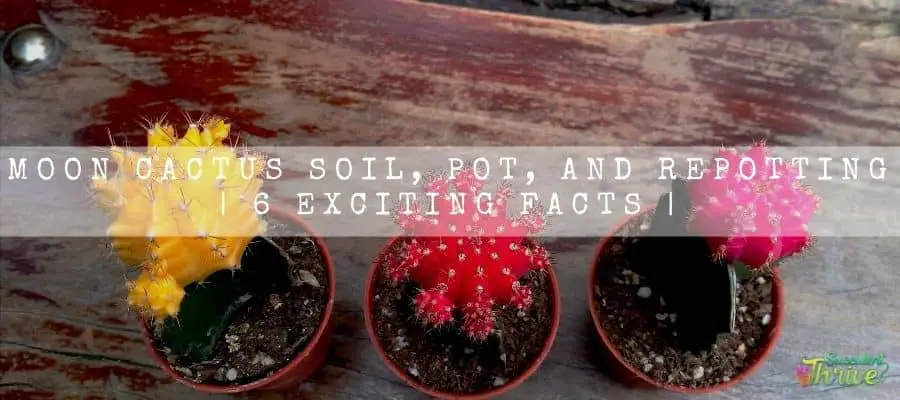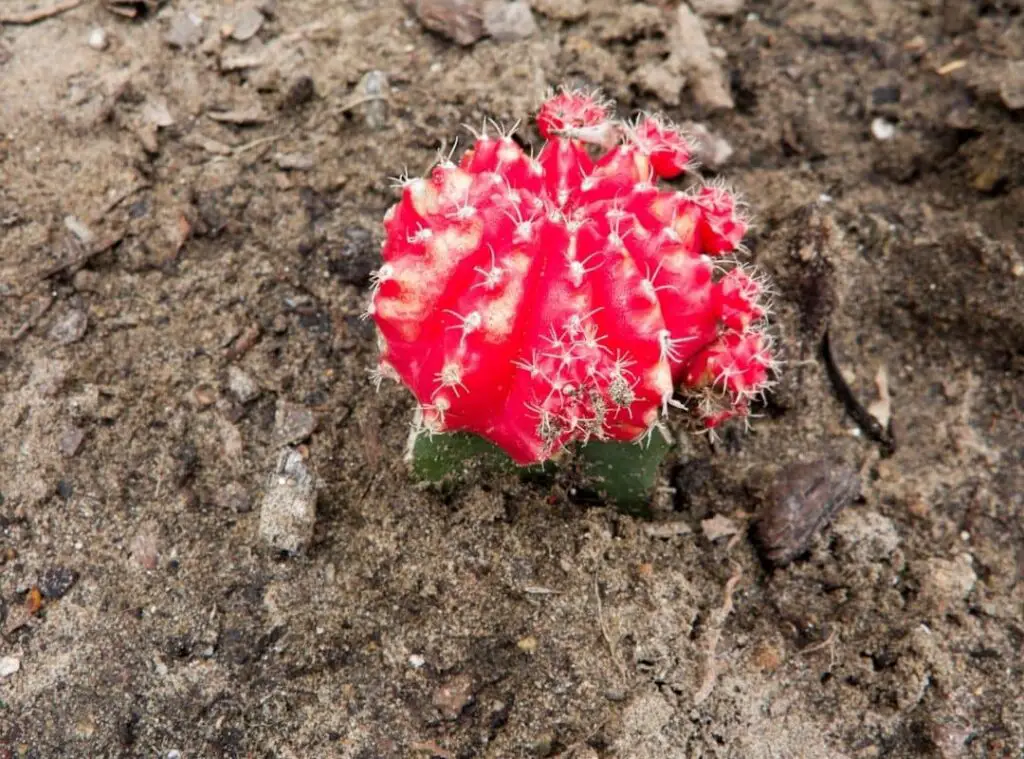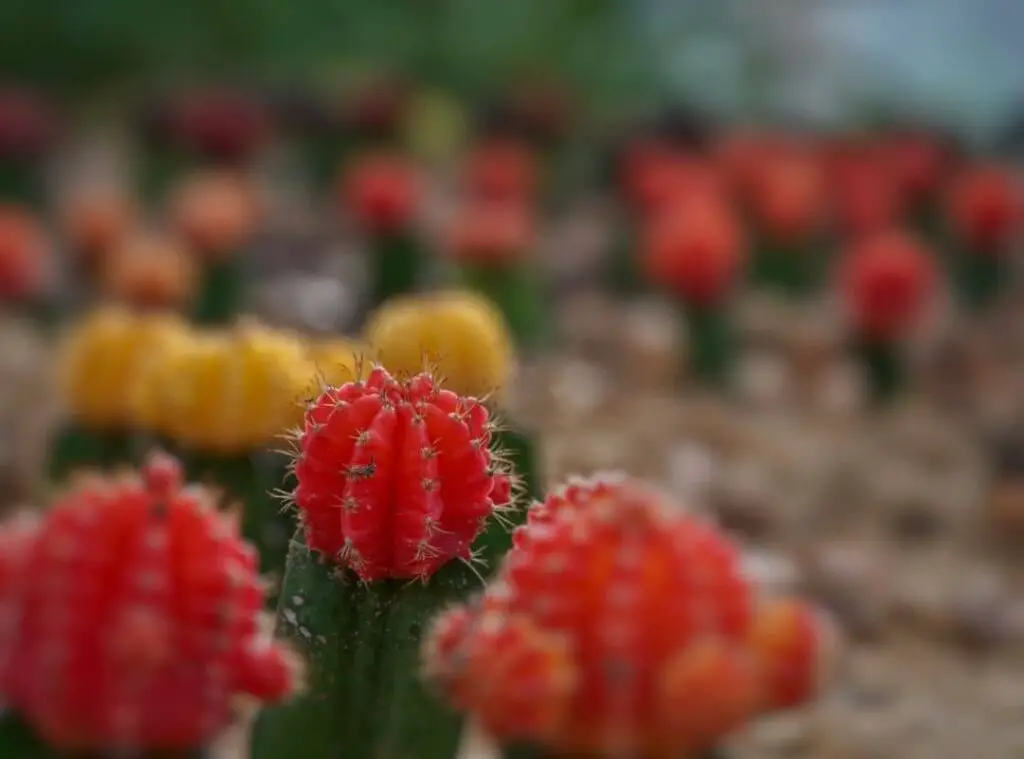Moon cactus is not a regular house plant. They produce via drafting technology. Therefore you must learn about moon cactus soil requirements before purchasing the plant.
In this article i am going to explain that to you. So keep reading.

What are they
Moon cactus are native plants in desert areas of South America. These plants do not have chlorophyll which is usually required to produce energy via photosynthesis process.
Hence why, you need to graft them with a host plant which could provide all the essential nutrients for the moon cactus to survive well.
Further you could spot these plants in numerous colors such as in hot pink, brilliant orange and even in neon too.
Best moon cactus soil
Moon cactus would require a rich well-draining cactus mix which has a low pH. Moreover, you need to make sure that the host cactus or base could also thrive well in those conditions .
To elaborate further on the characteristics of the best soil for the moon cactus, it has to be ideally a sandy soil mix which has good drainage.
To fasten the draining of a soil mix, you could be tactful in adding elements such as pebbles or small stones to the potting medium and that would perfectly fit in as a great soil mix for the moon cactus.
Further you could grow them in a soil mix which comprises sand and green fertilizer substances. You can also add elements such as broken leaves and dead plant materials in the soil medium.
It is very important that you add sand to the soil medium simply because they need a well-drainage.
How to choose a pot for moon cactus
Best is to use unglazed shallow pots which have sufficient draining holes to grow moon cactus.
When you have numerous draining holes, that would make sure that excess water will drain away from those holes and will avoid water getting stranded in the base of the pot.
Further moon cactus would thrive in crowded homes. In other words, you could repot the moon cactus in the same pot for a few years.
Further, you do not need to provide larger pots simply because they have a shallow root system. As such, you only need to provide a small pot along with enough draining holes and they would do well.

Guide to plant moon cactus
Provide them the right amount of light and shade
Providing an adequate amount of sunlight is very crucial for the rootstock cactus purely because it would be beneficial for the photosynthesis.
As such, I would recommend placing the moon cactus closer to a bright sunny window.
Having said that, do not expose your cactus for intense sunlight and make sure that it will only get partial sunlight only.
Just like the rest of the cactus and succulents, if you give them with direct sunlight, it will badly impact the cactus.
In case, if you are growing moon cactus on a windowsill, make sure that blinds would defend the cactus from receiving direct sunlight.
As you know already, the moon cactus’ natural habitat are the desert areas in South America, so it could withstand full bright sunlight for sometime during the summer season.
If you leave them in darker areas, it will contribute to the deterioration of the cactus.
Watering the moon cactus as appropriate
Moon cactus just like most other cactus and succulents would require little watering and you do not have to water them frequently.
If you are someone who lives in areas where you get rain falls, I would suggest you place them in a covered porch in case you have grown them outdoors.
If you are unsure whether you need to water the cactus , you could just feel the soil and see whether you need to water them or not.
If you spot any dry dirt and dust, you could commence watering them as adequate only. Avoid over wearing them at any given point of time.
Unless it would make the soil mix soggy and damp and the pot waterlogged too. When this takes place, potting soil could run from the pot edges as well.
Do not water the older moon cactus during the winter season. When I say older, it would be about one year older or more.
However, if you own a young moon cactus, you could water them on a minor level during the winter season.
Proper temperature
Moon cactus are fond of warmer temperatures and best is to grow them at room temperature.
When you grow them indoors, you could place them near a window and let it gain adequate heat levels.
Avoid exposing these cacti in scorching sunlight as it could harm them. The ideal temperatures to grow the moon cactus would be 6 degrees Fahrenheit to 77 degrees Fahrenheit.
When it comes to the base part of the cactus, they are hardier than the top part and they have different requirements in terms of temperature when compared to the top part of the cactus.
If you live in USDA hardiness zones, 10 or 11, you could grow the cactus outdoors in a bright sunny spot with partial sunlight.
On the other hand, if you live in a temperate climate, if you are growing them indoors, protect the moon cactus from cold drafts such as open windows, air conditioning. Keep in mind that they are not tolerant of temperatures below 48 degrees Fahrenheit.

Humidity
Moon caucus are not fuzzy when it comes to the humidity aspect as they are easy going. The small moon cactus would love to grow in relatively humid levels.
Having said that, they could also grow well in low humidity levels as well.
I would encourage a slight misting on and off as that would be quite useful in keeping this colorful cactus healthy and vigorous. Best is to do a little misting particularly during the winter season.
Do moon cactus need repotting?
You could report the moon cactus if it is essential. You may do that in warmer seasons. So it could be either late spring or early summer.
They usually tend to grow in a compact manner. However, if you feel like you need to provide them fresh growing conditions , you could proceed with repotting.
They grow well when they become slightly rootbound. However, when you spot the roots coming out from the pot’s drainage holes you need to consider repotting.
When you repot it will provide a fresh soil mix and it would help to stimulate the growth of the moon cactus. Not only that but also it would help to extend the cactus life span as well.
How do you repot a moon cactus?
- First of all, you should water your moon cactus one week prior to repotting them. Water them thoroughly.
- Once you see the soil is dry, you could gently take off the cactus. When you do that, pull the cactus from the green stock without harming the structure of the cactus.
- To get rid of the old soil you could give it a gentle shake. Observe whether there are any dead or diseased roots present in the cactus.
- If so, remove those unwanted roots as appropriate. Next you could fill the new pot half with a soil mix which is rich and well-draining.
- Now, you could repot the plant. However, when you repot, ensure that the cactus is in the same height as you had grown it before.
- Now you could add more potting medium and make the cactus stable by pressing the soil around the rootstock.
- After that, you could locate the cactus in a location where they get bright and indirect sunlight.
- Avoid watering them for about one week so that you could avoid any potential root rot there. You need to water them once the soil is dry.
Related questions
How often should you water a moon cactus?
You could water the moon cactus sparingly once you realize the soil is in dry condition only.Do not water the older moon cactus in winter.
Is the moon cactus succulent?
Yes, the moon cactus are succulents which are distinctive in color. It is just that they do not contain chlorophyll to produce energy from the photosynthesis.
Does moon cactus need sunlight?
Moon cactus require bright and indirect sunlight to thrive well. You need to be extra careful in providing them adequate sunlight particularly when you are growing them indoors.
How long do moon cactus live?
To answer this, the moon cactus would stay alive for one year to three years on average. Having said that, there could be some moon cactus which could live longer than that as well.
Read Next Moon Cactus Size | 4 Problems Everyone Has About Them |
